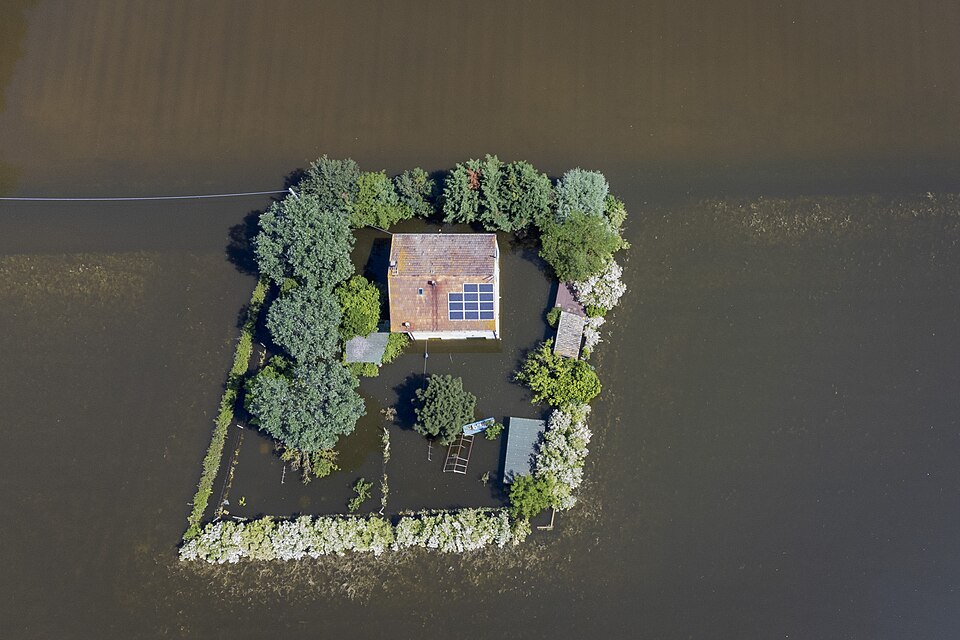As floods become more common in Europe, the cost of insurance grows, a financial burden that weighs heaviest on those with least.
Anna Toniolo is a freelance journalist and a member of the FADA Collective. Corina Petridi is a data journalist based in Athens, currently working for the independent investigative outlet Solomon. Pierluigi Bizzini is a freelance journalist and a member of FADA Collective.
Cross-posted from Green European Journal

When Storm Daniel hit the central Greek region of Thessaly in September 2023, dieticians and farmers Athina Balafa and Charalambos Laiopoulos, her husband, lost everything: their home, car, dietetics office, and crops. Farkadona, the small town where they lived, was all but destroyed by the storm.
In the aftermath of the disaster, Athina and Charalambos received little help from the government. The private insurance they had covered their office, but not from natural disasters. Since then, the couple and their kids have been staying at Athina’s sister’s house in Trikala, a 30-minute drive from Farkadona, while trying to rebuild their lives from scratch.
Across the Mediterranean, in Italy’s northern region of Emilia-Romagna, many families have had similar experiences. The region was hit by violent floods in 2023 and 2024 that left 18 dead. In Traversara, a small village home to just over 400 people in the province of Ravenna, the “red zone” – the area most heavily affected by the floods – still carries the scars of the destruction. Wild grass towers over the doors of abandoned houses, their walls torn open, tree trunks still wedged in window grates. It’s a place frozen in time since the day the water swept life away.
In both countries, people and businesses are increasingly turning to private insurers – in some cases forced by their governments – to protect themselves from growing climate risk. But not everyone can afford the rising premiums.
Who pays for climate change?
Traversara and Farkadona are just two of many European communities hit by the impacts of climate change. Europe is the fastest-warming continent in the world. Heatwaves are becoming increasingly frequent and precipitation patterns are shifting. The Mediterranean in particular is warming 20 per cent faster than any other region: with average temperatures already having increased by 1.5 degrees Celsius above pre-industrial levels, it has experienced more frequent and intense heatwaves. Moreover, between 2023 and 2024, the Mediterranean region was hit by some of the most destructive storms in its recent history. Residential and agricultural areas were flooded in Italy, Greece, Spain, Libya, Turkey, and other countries.
In September 2023, Storm Daniel, one of the deadliest cyclones ever recorded in the Mediterranean, hit Greece, Turkey, Bulgaria, and Libya. In Greece, the storm caused massive destruction in Thessaly, the country’s main agricultural region, leading to the death of 17 people and hundreds of thousands of animals. Conservative estimates put financial losses at more than 2.5 billion euros.
Earlier, in May 2023, the northern Italian region of Emilia-Romagna was hit by two floods in less than 20 days. It saw the highest level of rainfall recorded since 1961 – more than three times the usual amount for that time of year. As a result, 23 rivers overflowed, triggering landslides and flash floods that caused 17 deaths. The EU estimated damages at 8.8 billion euros.
Emilia-Romagna was hit again in 2024 by further extreme weather events that triggered additional floods, causing one fatality.
Between 1980 and 2024, financial losses due to weather and climate events in the EU totalled 822 billion euros. Floods were responsible for 47 per cent of these losses. With Greece and northern Italy identified as some of “the most vulnerable sub-areas of the Mediterranean”, and extreme weather events becoming more frequent and destructive, the question that arises is who will be responsible for the cost of climate change.
Insurance frenzy
Shortly after the floods, governments in both countries made it clear that they would no longer bear sole financial responsibility for disaster relief.
In September 2024, Italy’s civil protection minister Nello Musumeci stated: “The time when the state could step in and provide resources for everyone, forever, is over.” Speaking at a conference organised by ANIA, the National Association of Insurance Companies, he stressed that prevention “must also be the responsibility of every citizen.”
Similarly, a few days after the Thessaly floods, Greek prime minister Kyriakos Mitsotakis said that “private insurance for medium and large enterprises should be mandatory.” He also added: “It’s time to open up a public discussion about mandatory private insurance for all homes and businesses.”
Indeed, Italy and Greece have introduced obligatory private insurance against natural disasters for certain sectors. In Greece, owners must take out insurance for businesses with an annual turnover exceeding 500,000 euros, as well as for vehicles. The Greek government is also incentivising civilians to buy property insurance by introducing tax reductions. In Italy, insurance against natural disasters is mandatory for all businesses except those in the agricultural sector, because they are already covered by the National Mutual Fund for damage caused by floods, frost, and drought.
In theory, insurance policies represent a simple and effective way to protect people and businesses from the growing frequency of extreme weather events. However, in practice, insurance coverage – especially in areas previously hit by natural disasters – is often hampered.
Responding to necessity
For this investigation, we designed a survey through which more than 370 people and businesses from Emilia-Romagna and Thessaly shared their experiences regarding compensation and their stance on private insurance, among other things. We found that in both countries, more residents have either bought a private insurance plan, or declared they are more inclined to buy one as a result of the floods.
Our survey found that before Storm Daniel, only 11.5 per cent of the respondents in Thessaly owned private insurance that covered them for natural disasters. This percentage has almost doubled two years after the floods: 20 per cent of respondents are now insured against natural disasters, while another 26 per cent are considering joining an insurance plan.
Similarly, in Emilia-Romagna, only two per cent owned insurance for natural disasters before the floods, which has now risen to 26 per cent. In both countries, those who didn’t have insurance before the floods said they “didn’t think it was necessary”. Most respondents who purchased insurance after the floods said they had done so to ensure timely and adequate compensation in the event of another natural disaster.
Survey responses, confirmed by reports from the affected areas, indicate that government compensation for flood damages was often delayed and insufficient, leaving many residents and business owners struggling to recover fully from the disasters.
Rising risks and soaring demands
In March 2024, six months after Daniel, Athina and Charalambos tried to purchase private insurance for their office, but the insurer rejected their request because Farkadona was still in a “state of emergency”. The insurer got back to them in early September 2025, telling the couple they could now insure both their business and their home. In the end, the couple decided not to purchase the policy. Athina said that the premium was reasonable, but the contract did not explicitly say that flood was covered.
Two insurers working in the area confirmed to us that for almost a year after the flood, some insurance companies did not provide coverage for entire postal codes, including Farkadona. One of them said that some companies are still not covering specific risks such as subsidence – a phenomenon where the ground sinks due to earthquakes, floods, or mining activities, among other reasons.
Kostas Karatzoulis, an insurer based in Farkadona, says that more people are trying to get in touch with him after the devastating floods, and that his clientele has gone up by 25-30 per cent since Storm Daniel. However, he also states that insurance companies are conducting far more thorough checks when individuals or businesses seek insurance, while in the past they would most likely have approved applications even for houses built close to a river. “It’s not that easy to get insurance these days,” Karatzoulis says.
Similarly, in Sant’Agata sul Santerno – a town about 15 kilometres away from Traversara that was also heavily hit by the floods in 2023 – fear that another disaster might strike is widespread, and private insurance policies have become more popular as a result. But as Massimo Tarozzi, a resident affected by the floods and an insurance agent himself, explained, “the few companies that still cover floods are struggling. Most [companies] no longer offer such policies in certain zones because the risk is considered too high.”
He admits that when it comes to homes, he would be hesitant to sell a flood policy – partly because areas that have already been hit by severe floods carry a much higher risk, making it likely that similar extreme weather events will happen again. Furthermore, in places that have suffered multiple floods, it becomes difficult to determine which damage was caused by which event. This uncertainty also makes it harder to assess liability and decide what damages should be covered and what shouldn’t. “In insurance,” he says, “past damage matters: if you had a loss today and it happens again in the same spot tomorrow, I probably won’t pay, unless it’s caused by something different.”
“If it happens again,” he adds, “the insurer can claim it was already damaged before”.
Ever-higher premiums
But insurance companies’ reluctance to provide coverage in the face of climate risk is not the only obstacle for those seeking to buy a policy. In Italy, high premiums are becoming a problem, especially for businesses that are legally required to take out insurance.
Mattia Lucatini is the director of Artistation, a music and arts school in Faenza, a city of about 60,000 people in the province of Ravenna. Walking through the school’s freshly renovated halls, he explains that it’s the second time they have had to rebuild everything from scratch, after being hit by three floods between May 2023 and September 2024.
“The first time we lost everything, at least 500,000 euros in damages,” he recalls. “All our instruments were inside.” By October 2024, the school was finally ready to reopen – everything had been rebuilt and replaced, but just days before the inauguration, another flood hit.
When the first floods struck in May 2023, Artistation was covered by a natural catastrophe insurance policy, but only 40 per cent of the losses were reimbursed. By the time the second flood hit in September 2024, Lucatini had just renewed the policy, which allowed him to claim compensation for all the damages – two floods in May 2023 and another in September 2024. At the next renewal, however, Unipol, his insurer, refused to extend the coverage due to the high risk. “Luckily, I found another company willing to insure us,” he explains. “This one covers up to 85 per cent of the damages, but the price has changed dramatically. What used to cost a few hundred euros a year has now risen to a few thousand.”
We asked Unipol if they could explain how natural catastrophe insurance works within their organisation and what impact the new law requiring businesses to take out coverage against climate-related events will have. They replied: “At the moment, there is no one available to discuss the topics you mentioned.”
A June 2024 report by IVASS – the Italian Insurance Supervisory Authority – analysing 46 standard natural catastrophe policies stressed the need to simplify products and procedures to ensure firms comply with Italy’s mandatory disaster insurance law.
Reclaim Finance, an NGO conducting research on finance and climate, said that “it’s not surprising that people would want to take out insurance after experiencing a loss. However, they are likely to face higher premiums than other clients who have not yet suffered such losses.”
Spreading the risk
But insurance companies cannot simply withdraw from regions that are considered riskier, says the European Insurance and Occupational Pensions Authority (EIOPA). By refusing to insure certain areas, EIOPA told us, insurers are basically “negating their very existence”.
“It would be easy for some of them to move away from risky areas, but in the end, that is not in the interest of the sector itself, because then they would get less and less relevant,” said Marie Scholer, a senior expert on Policy Sustainable Finance at EIOPA.
Pietro Negri, a senior policy advisor at the Forum for Sustainable Finance and Secretary General of AIBA (the Italian Association of Insurance and Reinsurance Brokers), suggested that “the more people get insured, the better risk peaks can be managed.” If insurers can count on everyone being covered, he said, they can spread out the risk and stabilise premiums for all, “creating a virtuous circle”. At least for now, there are still no fixed or government-imposed premium rates in Italy or Greece, since this would be “against the European Union’s free market rules”. Negri said.
In recent years, insurance payouts for damages have risen sharply. In Italy, between 2018 and 2022, insurers paid out an average of 1.5-2 billion euros per year. In 2023 alone, that figure surged to over 7 billion euros – largely due to a series of exceptionally severe weather events, including major floods, that hit densely populated and heavily insured areas. Now that natural disaster coverage is mandatory for all businesses, with compliance timelines varying by company size, the total insured value is expected to rise to 2.2 trillion euros. On average, insurers are expected to face annual claims of around 1.2 billion euros, but in the event of an extreme catastrophe, losses could reach as high as 12 billion euros.
In Greece, since 2015, private insurance companies have paid more than 720 million euros for damages caused by natural disasters. Storms account for 72 per cent of these payouts, with Daniel being the most expensive one (more than 370 million euros).
At the same time, the insurance market in both countries has been growing. In Greece, the total assets and liabilities of insurance companies increased by 36.6 per cent during the period from 2016 to 2025. Just between 2023 and 2024, the total production of non-life insurance contracts increased by 9.4 per cent. In Italy, on the other hand, premium collection grew by 7.5 per cent in 2024 compared to the previous year. Confirming this trend, IVASS highlights in its latest annual report that the Italian insurance market is expanding in terms of total premiums collected.
Disaster relief and fossil financing
For the insurance industry, a central dilemma emerges: is the climate crisis a source of profit or a massive loss? According to Ariel Le Bourdonnec, an analyst at Reclaim Finance, “insurers are not playing an increasingly important role in paying claims for climate-related losses.” On the contrary, publicly listed insurers and reinsurers are pulling out of the riskiest areas to protect their profits and limit exposure to extreme climate events.
The insurance gap for climate risks isn’t shrinking, even though some insurers say they want to narrow it. In Europe, only 25 per cent of natural-disaster damage is insured, and worldwide, nearly two-thirds of these losses are not covered at all.
“One thing is certain,” Le Bourdonnec continues, “a warming planet is a more unstable planet; a more unstable planet is a riskier planet; a riskier planet leads to a society demanding ever more protection; and rising demand for protection provides a favourable context for insurers and reinsurers to increase their premiums.”
Still, many insurance companies continue investing in the fossil fuel industry, which is responsible for two-thirds of industrial greenhouse gas emissions over the past two centuries. Reclaim Finance argues that governments establishing public-private partnerships for natural catastrophe (re)insurance should impose strict conditions of access for insurers.
We asked EIOPA if the authority is regulating (re)insurers’ investments in fossil fuels. The EU authority said that there is no specific sustainability agenda and that it does not prescribe to insurers where to invest their money.
EIOPA is primarily concerned about insurers being solvent in case of a big catastrophe. In a report published in 2024, the authority highlighted that “fossil fuel-related stocks and bonds are more exposed to transition risks than assets connected to other economic activities.”
“We cannot say any investments are prohibited in fossil fuels, but evidence shows that if you invest in fossil fuels, you have a higher chance of going lower on those investments, losing money in those investments. And for that reason, the capital risk related to those investments would be higher than it would be in a non-fossil fuel investment,” said Marie Scholer from EIOPA.
Although insurance is seen as one of the few tools available to cope with the growing losses caused by increasingly frequent climate disasters, the reality is far more complicated. For residents who have lived through floods, the layers of difficulty are numerous. On the one hand, they feel abandoned by state authorities due to the slow pace of compensation, even though the government has no formal obligation to provide it. On the other hand, they are intimidated by private insurance schemes, which are not always easy to understand and navigate.
“Taking out an insurance policy feels like an act of resignation,” said Angelo Ravagli, spokesperson for the Traversara in Fiore committee and resident of the small town hit by the devastating 2024 flood – “a sign of defeat that shows we are no longer able to keep our territory safe.”
This investigation was carried out in collaboration with the Greek investigative newsroom Solomon and the Italian investigative newsroom FADA Collective. It was supported by Journalismfund Europe.




Be the first to comment